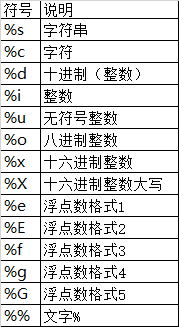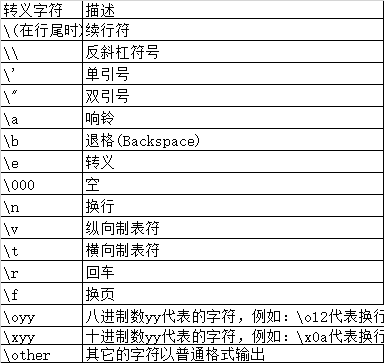目录
%用法
format用法
%用法
1、整数的输出
%o —— oct 八进制
%d —— dec 十进制
%x —— hex 十六进制
1 >>> print('%o' % 20)
2 24
3 >>> print('%d' % 20)
4 20
5 >>> print('%x' % 20)
6 14
2、浮点数输出
(1)格式化输出
%f ——保留小数点后面六位有效数字
%.3f,保留3位小数位
%e ——保留小数点后面六位有效数字,指数形式输出
%.3e,保留3位小数位,使用科学计数法
%g ——在保证六位有效数字的前提下,使用小数方式,否则使用科学计数法
%.3g,保留3位有效数字,使用小数或科学计数法
1 >>> print('%f' % 1.11) # 默认保留6位小数2 1.1100003 >>> print('%.1f' % 1.11) # 取1位小数4 1.15 >>> print('%e' % 1.11) # 默认6位小数,用科学计数法6 1.110000e+007 >>> print('%.3e' % 1.11) # 取3位小数,用科学计数法8 1.110e+009 >>> print('%g' % 1111.1111) # 默认6位有效数字
10 1111.11
11 >>> print('%.7g' % 1111.1111) # 取7位有效数字
12 1111.111
13 >>> print('%.2g' % 1111.1111) # 取2位有效数字,自动转换为科学计数法
14 1.1e+03
(2)内置round()
round(number[, ndigits])
参数:
number - 这是一个数字表达式。
ndigits - 表示从小数点到最后四舍五入的位数。默认值为0。
返回值
该方法返回x的小数点舍入为n位数后的值。
round()函数只有一个参数,不指定位数的时候,返回一个整数,而且是最靠近的整数,类似于四舍五入,当指定取舍的小数点位数的时候,一般情况也是使用四舍五入的规则,但是碰到.5的情况时,如果要取舍的位数前的小数是奇数,则直接舍弃,如果是偶数则向上取舍。
注:“.5”这个是一个“坑”,且python2和python3出来的接口有时候是不一样的,尽量避免使用round()函数吧
1 >>> round(1.1125) # 四舍五入,不指定位数,取整2 13 >>> round(1.1135,3) # 取3位小数,由于3为奇数,则向下“舍”4 1.1135 >>> round(1.1125,3) # 取3位小数,由于2为偶数,则向上“入”6 1.1137 >>> round(1.5) # 无法理解,查阅一些资料是说python会对数据进行截断,没有深究8 29 >>> round(2.5) # 无法理解
10 2
11 >>> round(1.675,2) # 无法理解
12 1.68
13 >>> round(2.675,2) # 无法理解
14 2.67
15 >>>
3、字符串输出
%s
%10s——右对齐,占位符10位
%-10s——左对齐,占位符10位
%.2s——截取2位字符串
%10.2s——10位占位符,截取两位字符串
1 >>> print('%s' % 'hello world') # 字符串输出2 hello world3 >>> print('%20s' % 'hello world') # 右对齐,取20位,不够则补位4 hello world5 >>> print('%-20s' % 'hello world') # 左对齐,取20位,不够则补位6 hello world 7 >>> print('%.2s' % 'hello world') # 取2位8 he9 >>> print('%10.2s' % 'hello world') # 右对齐,取2位
10 he
11 >>> print('%-10.2s' % 'hello world') # 左对齐,取2位
12 he
4、 其他
(1)字符串格式代码

(2)常用转义字符

format用法
相对基本格式化输出采用‘%’的方法,format()功能更强大,该函数把字符串当成一个模板,通过传入的参数进行格式化,并且使用大括号‘{}’作为特殊字符代替‘%’
位置匹配
(1)不带编号,即“{}”
(2)带数字编号,可调换顺序,即“{1}”、“{2}”
(3)带关键字,即“{a}”、“{tom}”
1 >>> print('{} {}'.format('hello','world')) # 不带字段2 hello world3 >>> print('{0} {1}'.format('hello','world')) # 带数字编号4 hello world5 >>> print('{0} {1} {0}'.format('hello','world')) # 打乱顺序6 hello world hello7 >>> print('{1} {1} {0}'.format('hello','world'))8 world world hello9 >>> print('{a} {tom} {a}'.format(tom='hello',a='world')) # 带关键字
10 world hello world
 通过位置匹配
通过位置匹配
 通过名字匹配
通过名字匹配
 通过对象属性匹配
通过对象属性匹配
 通过下标或key匹配参数
通过下标或key匹配参数
格式转换
‘b’ - 二进制。将数字以2为基数进行输出。
‘c’ - 字符。在打印之前将整数转换成对应的Unicode字符串。
‘d’ - 十进制整数。将数字以10为基数进行输出。
‘o’ - 八进制。将数字以8为基数进行输出。
‘x’ - 十六进制。将数字以16为基数进行输出,9以上的位数用小写字母。
‘e’ - 幂符号。用科学计数法打印数字。用’e’表示幂。
‘g’ - 一般格式。将数值以fixed-point格式输出。当数值特别大的时候,用幂形式打印。
‘n’ - 数字。当值为整数时和’d’相同,值为浮点数时和’g’相同。不同的是它会根据区域设置插入数字分隔符。
‘%’ - 百分数。将数值乘以100然后以fixed-point(‘f’)格式打印,值后面会有一个百分号。
1 >>> print('{0:b}'.format(3))2 113 >>> print('{:c}'.format(20))4 5 >>> print('{:d}'.format(20))6 207 >>> print('{:o}'.format(20))8 249 >>> print('{:x}'.format(20))
10 14
11 >>> print('{:e}'.format(20))
12 2.000000e+01
13 >>> print('{:g}'.format(20.1))
14 20.1
15 >>> print('{:f}'.format(20))
16 20.000000
17 >>> print('{:n}'.format(20))
18 20
19 >>> print('{:%}'.format(20))
20 2000.000000%
21 >>>
进阶用法
进制转换
 2进制、8进制、10进制、16进制
2进制、8进制、10进制、16进制
左中右对齐及位数补全
(1)< (默认)左对齐、> 右对齐、^ 中间对齐、= (只用于数字)在小数点后进行补齐
(2)取位数“{:4s}”、"{:.2f}"等
 左中右对齐及位数补齐
左中右对齐及位数补齐
正负符号显示
 正负符号显示 %+f, %-f, 和 % f的用法
正负符号显示 %+f, %-f, 和 % f的用法
百分数%
 百分数%
百分数%
时间
 时间
时间
逗号","分隔金钱,没以前进位
 逗号","分隔金钱
逗号","分隔金钱
占位符嵌套
 占位符嵌套
占位符嵌套
占位符%s和%r
 占位符%s和%r
占位符%s和%r
format的用法变形
\# a.format(b)
>>> "{0} {1}".format("hello","world")
'hello world'# f"xxxx"
\# 可在字符串前加f以达到格式化的目的,在{}里加入对象,此为format的另一种形式:
>>> a = "hello"
>>> b = "world"
>>> f"{a} {b}"
'hello world'name = 'jack'
age = 18
sex = 'man'
job = "IT"
salary = 9999.99print(f'my name is {name.capitalize()}.')
print(f'I am {age:\*^10} years old.')
print(f'I am a {sex}')
print(f'My salary is {salary:10.3f}')# 结果
my name is Jack.
I am \*\*\*\*18\*\*\*\* years old.
I am a man
My salary is 9999.990
本文转自 https://www.cnblogs.com/yitongtianxia666/p/17622537.html,如有侵权,请联系删除。
】)




)






)






